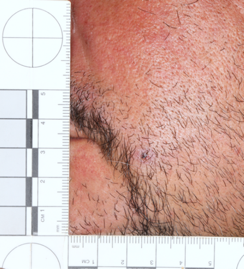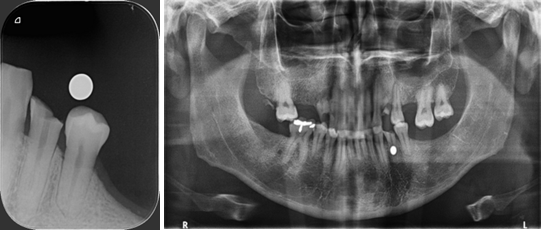Serviços Personalizados
Journal
Artigo
Indicadores
-
 Citado por SciELO
Citado por SciELO -
 Acessos
Acessos
Links relacionados
-
 Similares em
SciELO
Similares em
SciELO
Compartilhar
Medicina Legal de Costa Rica
versão On-line ISSN 2215-5287versão impressa ISSN 1409-0015
Med. leg. Costa Rica vol.40 no.2 Heredia Set./Dez. 2023
Case reports
Dental trauma and facial injuries by air guns: case report
1 Espec. Odontología Forense. Patología y Cirugía Oral. MSc. Administración de Servicios de Salud Sostenible. Profesor Facultad de Odontología Universidad de Costa Rica. Unidad de Odontología Forense, Departamento de Medicina Legal, Organismo de Investigación Judicial. Heredia, Costa Rica. ORCID ID: https://orcid.org/0000-0001-6478-5407
Air guns have been used for many years for a variety of purposes ranging from recreational shooting to pest control. The most common are those that shoot "pellets" or metallic spheres that can penetrate tissues depending on the type of load and the length of the barrel.
A clinical case is presented of a male who was assaulted with a CO2-loaded pistol-type weapon, hit at facial level, and suffered laceration of the lip's skin and complicated dental fracture.
Keywords: Air guns; compressed air; pellets; ball bearings; dental trauma; CO2; facial wounds
Introduction
Air guns have been considered "toys" in many countries as they are not firearms themselves because they use air or other gas to propel a projectile. The most common are metallic spheres commonly called "pellets" or other forms or names (1). These weapons are used for recreational shooting, small-game hunting, pest control, and combat simulations (2).
Although they usually generate minor wounds, one of the dangers they represent is that in addition to penetrating the tissues, due to their size, they can be easily embolized and even cause death (3). Some 80% of this type of weapon has the capacity to generate up to 350 feet per second (pps) and 50% reach speeds between 500 to 930 feet per second. In this aspect, it is important to take into consideration that only 150 pps are needed to penetrate human skin, and 200 pps are needed to generate bone fractures (4).
Epidemiological studies have shown that the majority of traumas with this type of weapon occur in people under 25 years of age (5), especially between the ages of 10 and 19 (6), and occur mainly in gaming situations, however, it is known that there are many cases that are not reported and that the real situation behind the events is unknown (2).
Objective
Describe the mechanism of action of compressed air weapons, as well as the possible injuries that can be generated when they are used during attacks at the orofacial level.
Materials and methods
For this study, a bibliographic search was carried out using different virtual platforms such as PubMed, Scielo and Medline in the National Library of Health and Social Security (BINASSS) as well as the SIBDI platform of the University of Costa Rica Library System. The words used were: air guns, pellets, BB's, non-powder firearms, injuries.
Case report
The case is presented of a 49-year-old male individual who refers that he was assaulted with a BB gun, describes that he received multiple impacts in his body and describes that he presents pain in the left side of the face and a fractured tooth ipsilaterally, additionally he reports that he perceives a foreign body inside the soft tissues in the direction of the fractured tooth.
The extraoral examination showed a skin perforation of approximately 2 x 2 mm with the presence of a blood crust located 2 cm from the left labial commissure (figure 1), there were no associated sensory alterations.

Figure 1 Note the area with a spherical hematological crust that coincides with the shape of the pellet (projectile) pointed by the arrow.
Intraorally there is a recent complicated coronal fracture of the lower left first premolar, the adjacent teeth do not present lesions.

Figures 2 and 3. Recent complicated fracture of the lower left first premolar, note the sharp edges and absence of pigmentation in the dentin that demonstrate that the fracture is recent, in the central portion the pulp chamber is exposed.

Figures 3 and 4. Periapical radiography and orthopantomography. The images clearly show a spherical, radio-opaque body compatible with a metallic sphere popularly known as a "pellet" still present in the soft tissue, coinciding with the trajectory that caused the fracture of the lower left first premolar.
Discussion
Air guns are considered "toys" in many countries (7), However, the use of this type of weapon as a means of aggression and even as a tool for committing crimes has been reported in places such as the United Kingdom since 1973 (6)(8).
Injuries to the head and neck range from ecchymosis, hematomas and skin lacerations to ocular voiding (2), maxillary sinus perforations (6), perforations in ethmoid sinuses (4) and even brain penetrations (9)(10).
Dental or dentoalveolar fractures have been rarely reported in this type of cases (7), It is therefore important to raise awareness of the possible injuries that can be caused by this type of weapon. Teeth are the most resistant structures in the human body and therefore act as a protective barrier against low velocity projectiles as occurred in the present case.
Conclusion
It is necessary that the forensic odontological evaluation be carried out in a comprehensive manner, both clinically and radiographically, to guarantee that the causal link between the investigated facts and the findings can be demonstrated in an objective and technical-scientific manner.
Photographic documentation is important to have material evidence in case it is required during legal proceedings.
In addition, the general oral and dental condition and the previous state should be considered for the purposes of permanent disability.
Bibliografía
1. McNeill AM, Annest JL. The ongoing hazard of BB and pellet gun-related injuries in the United States. Ann Emerg Med (Internet). 1995 (cited 2023 Aug 31);26(2):187-94. Available from: https://pubmed.ncbi.nlm.nih.gov/7618782/ [ Links ]
2. Jones M, Kistamgari S, Smith GA. Nonpowder Firearm Injuries to Children Treated in Emergency Departments. 2019;144(6). [ Links ]
3. Ng’walali PM, Ohtsu Y, Muraoka N, Tsunenari S. Unusual homicide by air gun with pellet embolisation. Forensic Sci Int. 2001 Dec 15;124(1):17-21. [ Links ]
4. Chhetri DK, Shapiro NL. A case of a BB-gun pellet injury to the ethmoid sinus in a child. Ear, Nose Throat J. 2004;83(3):176-80. [ Links ]
5. Isaac A, AlQudehy Z, El-Hakim H. Penetrating injury to the parapharyngeal space caused by a BB gun in a pediatric patient. J Pediatr Surg Case Reports (Internet). 2013;1(2):25-7. Available from: http://dx.doi.org/10.1016/j.epsc.2013.01.002 [ Links ]
6. Owen-Johnstone M, Broderick D, Graham RM. Air guns and their wider relevance to the dental profession. Br Dent J. 2022;232(12):861-3. [ Links ]
7. Colgan L, Shannon D. Dento-alveolar and facial injury caused by air gun pellets. Dent Update. 2010;37(5):323-5. [ Links ]
8. Ceylan H, McGowan A, Stringer MD. Air weapon injuries: A serious and persistent problem. Arch Dis Child. 2002;86(4):234-5. [ Links ]
9. Niryana W, Irawan H, Widyadharma IPE. An intracerebral penetration of air shotgun pellet in toddler: A case without neurological sequelae. Open Access Maced J Med Sci. 2018 Aug 20;6(8):1446-9. [ Links ]
10. Rahmatullah MI, Parenrengi MA, Suryaningtyas W. Unintentional penetrating brain injuries caused by air rifles in teenagers: Two case report. Interdiscip Neurosurg. 2021 Sep 1;25:101203. [ Links ]











 texto em
texto em 



